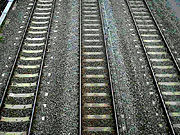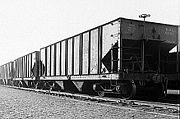Railroad car
 |
| Rail transport |
|---|
| Operations |
| Stations |
| Trains |
| Locomotives |
| Rolling stock |
| History |
| History by country |
| Terminology |
| By country |
| Accidents |
|
|
A railroad car or railway carriage is a vehicle on a rail transport system (railroad or railway) that is used for the carrying of cargo or passengers. Cars can be coupled together into a train and hauled by one or more locomotive. Passenger cars can be self propelled in which case they can be single or multiple units.
Most cars carry a "revenue" load, although "non-revenue" cars exist for the railroad's own use, such as for maintenance-of-way purposes. Such uses can generally be divided into the carriage of passengers and of freight. "Revenue" cars are basically of two types: passenger cars, or coaches, and freight cars or wagons.
Contents |
Passenger cars



Passenger cars, or coaches, vary in their internal fittings:
In standard gauge cars, seating is usually between three and five seats across the width of the car, with an aisle in between (resulting in 2+1, 2+2 or 3+2 seats) or at the side. Tables may be present between seats facing one another. Alternatively, seats facing the same direction may have access to a fold-down ledge on the back of the seat in front.
- If the aisle is located between seats, seat rows may face the same direction, or be grouped, with twin rows facing each other. Sometimes, for example on a commuter train, seats may face the aisle.
- If the aisle is at the side, the car is usually divided in small compartments. These usually contain 6 seats, although sometimes in second class they contain 8, and sometimes in first class they contain 4.
- In vehicles intended for commuter services seats are sometimes placed with their backs to the carriage side. This gives a wide accessway and standing room which accommodates standing passengers at peak times and improves loading and unloading speeds.
Passenger cars can take the electricity supply for heating and lighting equipment from two main sources - either directly from a head end power generator on the locomotive via bus cables; or by an axle powered generator which continuously charges batteries whenever the train is in motion.
Modern cars usually have either air-conditioning or windows that can be opened (sometimes, for safety, not so far that one can hang out), or sometimes both. Various types of onboard train toilet facilities may also be provided.
Other types of passenger car exist, especially for long journeys, such as the dining car, parlor car, disco car, and in rare cases theater and movie theater car. In some cases another type of car is temporarily converted to one of these for an event.
Observation cars were built for the rear of many famous trains to allow the passengers to view the scenery. These proved popular, leading to the development of dome cars multiple units of which could be placed mid-train, and featured a glass-enclosed upper level extending above the normal roof to provide passengers with a better view.
Sleeping cars outfitted with (generally) small bedrooms allow passengers to sleep through their night-time trips, while couchette cars provide more basic sleeping accommodation. Long-distance trains often require baggage cars for the passengers' luggage. In European practice it used to be common for day coaches to be formed of compartments seating 6 or 8 passengers, with access from a side corridor. In the UK, Corridor coaches fell into disfavor in the 1960s and 1970s partially because open coaches are considered more secure by women traveling alone.
Another distinction is between single- and double deck train cars. An example of a double decker is the Amtrak superliner.
A "trainset" (or "set") is a semi-permanently arranged formation of cars, rather than one created 'ad hoc' out of whatever cars are available. These are only broken up and reshuffled 'on shed' (in the maintenance depot). Trains are then built of one or more of these 'sets' coupled together as needed for the capacity of that train.
Often, but not always, passenger cars in a train are linked together with enclosed, flexible gangway connections that can be walked through by passengers and crew members. Some designs incorporate semi-permanent connections between cars and may have a full-width connection, making in essence one longer, flexible 'car'. In North America, passenger equipment also employ tightlock couplings to keep a train reasonably intact in the event of a derailment or other accident.
Many multiple unit trains consist of cars which are semi-permanently coupled into sets; these sets may be joined together to form larger trains, but generally passengers can only move around between cars within a set. This "closed" nature allows the separate sets to be easily split to go separate ways. Some multiple-unit trainsets are designed so that corridor connections can be easily opened between coupled sets; this generally requires driving cabs either set off to the side or (as in the Dutch Koploper) above the passenger compartment. These cabs or driving trailers are also useful for quickly reversing the train.
|
|||||||||||
Freight cars




Freight cars or (UK: "wagons" or "trucks") exist in a wide variety of types, adapted to the ideal carriage of a whole host of different things. Originally there were very few types of cars; the boxcar (UK: "van"), a closed box with side doors, was among the first.
Common types of freight cars include:
- Aircraft Parts Car
- Autorack - (also called auto carriers) are specialized multi-level cars designed for transportation of unladen automobiles.
- Boxcar (or van) - box shape with roof and side or end doors.
- CargoSprinter - a self propelled container flatcar.
- Centerbeam cars
- Coil Car - a specialized type of rolling stock designed for the transport of coils of sheet metal, particularly steel. They are considered a subtype of the gondola car, though they bear little resemblance to a typical gondola.
- Covered hopper - similar to open top hoppers but with a cover for weather and temperature-sensitive loads.
- Double-Stack Car (or well car) - specialized cars designed for carrying shipping containers. These have a "well" with a very low bottom floor to allow double stacking.
- Flatcar (or flat) - for larger loads that don't load easily into a boxcar. Specialized types such as the depressed-center flatcar (aka "well car") exist for oversize items or the Schnabel car for even larger and heavier loads. With the advent of containerized freight, special types of flatcars were built to carry standard shipping containers and semi-trailers.
- Gondola - railroad cars with an open top but enclosed sides and ends, for bulk commodities and other goods that might slide off.
- Hicube boxcars
- Lorry - An open railroad car (gondola) with a tipping trough, often found in mines.
- Refrigerator car (or reefer) - a refrigerated subtype of boxcar.
- Side Dump Cars - used to transport roadbed materials such as, ballast, riprap, and large stone, and are able to unload anywhere along the track.
- Hoppers - similar to gondolas but with bottom dump doors for easy unloading of things like coal, ore, grain, cement, ballast and the like. Short hoppers for carrying iron ore are called ore jennys.
- Modalohr Road Trailer Carriers.
- Roll-block - a train designed to carry another railway train.
- Slate wagon - specialized freight cars used to transport slate.
- Stock Car - for the transport of livestock.
- Tank car (or tanker) - for the transportation of liquids.
- Transporter wagon - a wagon designed to carry other railway equipment.
- Conflat (UK) - A flat truck for carrying containers.
- Lowmac (UK) - A low-floor wagon for carrying machinery.
- Tippler (UK) Gondola (US) (or Lorry) - An open wagon with no doors or roof which are unloaded by being inverted on a Wagon Tippler (UK) or Rotary car dumper (US). They are, used for minerals, such as coal, limestone and iron ore as well as other bulk cargo.
The vast majority of freight cars fit into the above categories.
|
|||||||||||
Non-revenue cars

- Cabooses (or guard's vans or brakevans) which attach to the rear of freight trains to order to watch the train and assist in shoving moves.
- Clearance car, special car to check for obstructions.
- Handcars, which are powered by their passengers.
- Maintenance of way (MOW) cars, for the maintenance of track and equipment.
- Rail car mover — some of which resemble HiRail trucks.
- Railroad cranes
- Road-rail vehicle
- Scale test car
- Track tester
- Outfit Car or a Camp Car[1], a bunk car or modular home mounted on a flat car to house railroad employees.
Military cars

Military armoured trains use several types of specialized cars:
- artillery — fielding mixture of guns and machine guns
- infantry — fielding machine guns, designed to carry infantry units
- machine gun — dedicated to machine guns
- anti-air — equipped with anti-air guns
- command — similar to infantry wagons, but designed to be a train command center
- anti-tank — equipped with anti-tank guns, usually in a tank gun turret
- platform — unarmoured, with purposes ranging from transport of ammunition or vehicles, through track repair or derailing protection to railroad ploughs for railroad destruction.
- troop sleepers
See also
|
|
References
- ↑ ""General Code of Operating Rules: Section 5.12: Protection of Occupied Outfit Cars"". Retrieved on 06/19/2008.